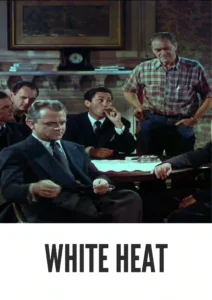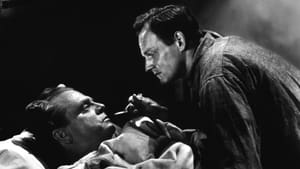Contact: info@alwanfilm.com
Video Sources 0 Views
- Watch trailer
- White Heat


Synopsis
Table of Contents
ToggleReview: White Heat 1949 Colorized – A Fiery Crime Thriller

Introduction
White Heat, released in 1949, stands as a classic crime thriller directed by Raoul Walsh. Renowned for its intense performances, gripping storyline, and iconic moments, this film noir masterpiece continues to captivate audiences with its portrayal of a ruthless criminal and his descent into madness. In this review, we’ll delve into the explosive world of White Heat and its lasting impact on cinema.
Check The Full Colorized Movies List
Check Our Colorized Movies Trailer Channel
Understanding White Heat 1949 Colorized: Director, Cast, and Genre
Directed by Raoul Walsh, White Heat features a powerhouse performance by James Cagney in the role of Cody Jarrett, a psychotic gangster with a mother complex. The film belongs to the crime thriller genre, known for its gritty realism, morally complex characters, and tense atmosphere.
Exploring the World of White Heat 1949 Colorized: Plot and Characters
White Heat follows the story of Cody Jarrett, a volatile and psychopathic gangster who leads a ruthless criminal syndicate. As Jarrett’s criminal empire grows, he becomes increasingly paranoid and unstable, leading to a series of violent confrontations with both law enforcement and his own associates. Against the backdrop of a seedy urban landscape, the film explores themes of loyalty, betrayal, and the destructive power of obsession.
The Art of Film Colorization
While White Heat was originally filmed in black and white, its early colorized version adds a new layer of intensity to its explosive visuals. The colorization process enhances the film’s gritty realism and captures the raw emotion of its iconic performances with striking clarity.
Early Colored Films: A Brief History
The history of early colored films is marked by innovation and experimentation as filmmakers sought to enhance the visual appeal of their movies. From hand-tinted frames to pioneering technicolor processes, the evolution of colorization techniques transformed the cinematic landscape, offering audiences a new way to experience the darkness and intensity of film noir.
White Heat (1949) and Its Early Colored Version
The decision to release White Heat in a colorized format was made with the intention of immersing audiences in the explosive intensity of its visuals and enhancing the film’s impact. While some purists may prefer the original black and white version, the early colorized edition of White Heat adds a new layer of depth to its atmospheric cinematography and captures the psychological complexity of its characters with breathtaking clarity.
The Debate Over Film Colorization
The debate over film colorization continues to divide audiences and industry professionals alike. While some argue that colorization breathes new life into classic films and makes them more accessible to modern audiences, others maintain that it compromises the artistic integrity of the original work. As technology advances and filmmaking techniques evolve, the debate over colorization remains a topic of ongoing discussion within the film community.
Examining White Heat (1949) as an Early Colored Film
Viewing White Heat in its early colorized iteration offers audiences a fresh perspective on its explosive visuals and intense performances. The colorization process enhances the film’s gritty realism and captures the raw emotion of James Cagney’s iconic portrayal of Cody Jarrett with stunning clarity. As viewers are drawn into Jarrett’s world of violence and paranoia, they are treated to a visceral experience that immerses them in the dark and dangerous world of organized crime.
Influence and Legacy: White Heat 1949 Colorized’s Impact on Cinema
White Heat is widely regarded as a classic of the crime thriller genre that continues to influence filmmakers and inspire new generations of cinephiles. Its intense performances, gripping storyline, and explosive visuals have left an indelible mark on cinema, shaping the way crime thrillers are made and appreciated to this day.
Director’s Cinematic Legacy: Beyond White Heat 1949 Colorized
Raoul Walsh’s directorial legacy extends far beyond White Heat, encompassing a diverse body of work that includes acclaimed films such as High Sierra and The Roaring Twenties. As one of the most respected filmmakers of his generation, Walsh was known for his ability to craft compelling narratives that explored the darker aspects of the human experience with depth and nuance. White Heat stands as a testament to his talent and creativity, solidifying his reputation as one of the great auteurs of classic Hollywood cinema.
Themes Explored in White Heat 1949 Colorized
At its core, White Heat explores themes of loyalty, betrayal, and the destructive power of obsession in the seedy underworld of organized crime. Through its intense performances and explosive visuals, the film offers a nuanced portrayal of the human condition, challenging viewers to confront their own beliefs about right and wrong as they navigate the treacherous world of Cody Jarrett.
Reception and Controversy Surrounding White Heat 1949 Colorized
Upon its release, White Heat received widespread critical acclaim for its intense performances, gripping storyline, and explosive visuals. While the decision to release the film in a colorized format sparked debate among purists, its enduring popularity has cemented its status as a timeless classic of the crime thriller genre.
Where to Watch White Heat 1949 Colorized Online
For those eager to experience White Heat for themselves, the film is readily available on popular streaming platforms such as Amazon Prime Video, Google Play Movies, and iTunes. Whether viewed in its original black and white format or its early colorized iteration, White Heat offers a cinematic experience that is both intense and visually stunning.
FAQs About White Heat 1949 Colorized
1. Is White Heat based on a true story?
No, White Heat is a fictional film that explores the gritty realism of the criminal underworld through the eyes of its morally complex characters. While the film’s storyline may draw inspiration from real-life events, its characters and plot are works of fiction.
2. Who starred in White Heat?
White Heat stars James Cagney in the role of Cody Jarrett, a volatile and psychopathic gangster with a mother complex. He is supported by a talented ensemble cast, including Virginia Mayo, Edmond O’Brien, and Margaret Wycherly.
3. What is the central message of White Heat?
At its core, White Heat explores the consequences of loyalty, betrayal, and the destructive power of obsession in the seedy underworld of organized crime. Through its intense performances and explosive visuals, the film offers a nuanced portrayal of the human condition, challenging viewers to confront their own beliefs about right and wrong as they navigate the treacherous world of Cody Jarrett.
4. Why was White Heat released in a colorized format?
The decision to release White Heat in a colorized format was made with the intention of immersing audiences in the explosive intensity of its visuals and enhancing the film’s impact. While some purists may prefer the original black and white version, the early colorized edition of White Heat adds a new layer of depth to its atmospheric cinematography and captures the psychological complexity of its characters with breathtaking clarity.
5. What is the legacy of White Heat?
White Heat is widely regarded as a classic of the crime thriller genre that continues to influence filmmakers and inspire new generations of cinephiles. Its intense performances, gripping storyline, and explosive visuals have left an indelible mark on cinema, shaping the way crime thrillers are made and appreciated to this day.
6. Are there any sequels or remakes of White Heat?
No, there have been no official sequels or remakes of White Heat. However, the film’s enduring popularity has inspired countless reinterpretations and homages in various media. Nonetheless, none have captured the intense performances and explosive visuals of the original 1949 classic.
7. Where can I watch White Heat online?
For those eager to experience White Heat for themselves, the film is readily available on popular streaming platforms such as Amazon Prime Video, Google Play Movies, and iTunes. Whether viewed in its original black and white format or its early colorized iteration, White Heat offers a cinematic experience that is both intense and visually stunning.
Conclusion
In conclusion, White Heat (1949) stands as a timeless classic of the crime thriller genre that continues to enthrall and inspire audiences with its intense performances, gripping storyline, and explosive visuals. Whether viewed in its original black and white format or its early colorized iteration, Raoul Walsh’s insightful direction and James Cagney’s powerhouse performance as Cody Jarrett offer a cinematic experience that is both thrilling and visually stunning.
As viewers are drawn into Jarrett’s world of violence and paranoia, they are treated to a visceral journey that challenges their beliefs about right and wrong and leaves a lasting impact on their understanding of the human condition. White Heat remains a testament to the enduring power of cinema and its ability to capture the darker aspects of the human experience with depth and nuance.



















